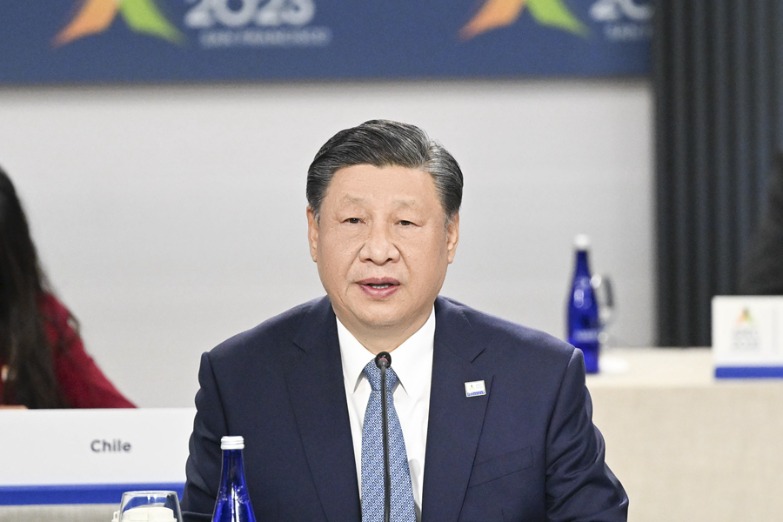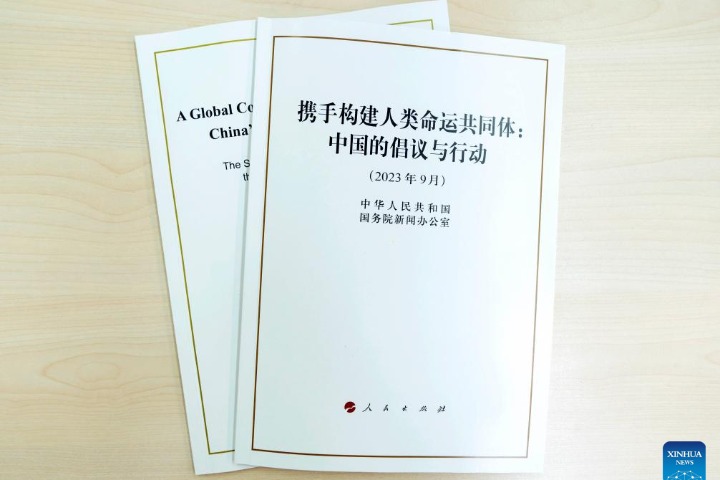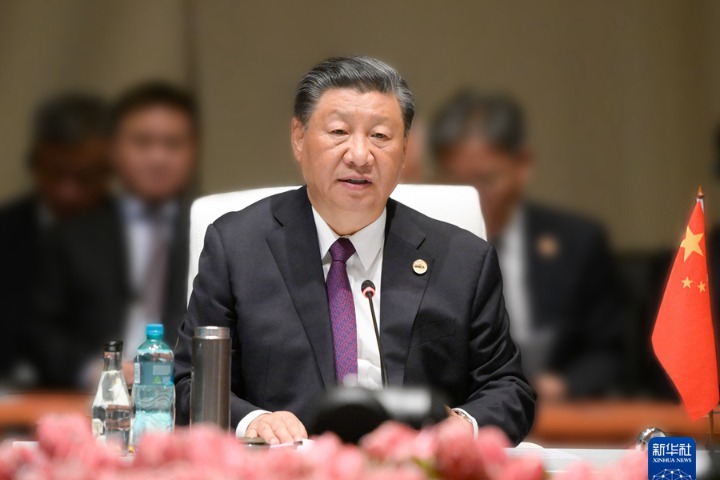全面建成小康社会:中国人权事业发展的光辉篇章(双语全文)
新华网 2021-08-12 15:14

二、消除绝对贫困实现基本生活水准权
II. Ending Extreme Poverty and Securing the Right to an Adequate Standard of Living
贫困是实现人权的最大障碍。中国共产党和中国政府高度关注农村贫困问题,持续推进扶贫开发事业,在消除贫困道路上不断取得新突破。中共十八大以来,中国政府把贫困人口全部脱贫作为全面建成小康社会的底线任务和标志性指标,组织实施了人类历史上规模空前、力度最大、惠及人口最多的脱贫攻坚战,完成了消除绝对贫困的艰巨任务。
Poverty is the biggest obstacle to human rights. The CPC and the Chinese government have directed extra attention to rural poverty, furthering development-driven poverty alleviation, and achieving a series of important breakthroughs. The 18th CPC National Congress in 2012 made ending extreme poverty China’s benchmark task in achieving moderate prosperity in all respects. By eliminating extreme poverty China has won the biggest and toughest battle against poverty in human history, to the benefit of the largest number of people.
根据中国农村居民每人每年生活水平在2300元以下(2010年不变价)的现行贫困标准,经过中共十八大以来8年持续奋斗,到2020年底,中国现行标准下9899万农村贫困人口全部脱贫,832个贫困县全部摘帽,12.8万个贫困村全部出列,区域性整体贫困得到解决。改革开放以来,按照现行贫困标准计算,中国7.7亿农村贫困人口摆脱贫困;按照世界银行国际贫困标准,中国减贫人口占同期全球减贫人口70%以上。中国提前10年实现《联合国2030年可持续发展议程》减贫目标,为全球减贫事业发展和人类发展进步作出了重大贡献。
By the end of 2020, by China’s current poverty threshold of RMB2,300 per person per year (based on the 2010 price index), all of the 99 million rural poor, as well as the 832 counties and 128,000 villages classified as poor, had emerged from poverty, and regional poverty was eliminated.
Since the launch of reform and opening up in 1978, 770 million rural poor living below China’s poverty line have been raised from poverty; against the World Bank’s international poverty line, the number of people lifted out of poverty in China accounts for more than 70 percent of the world total during the same period. China realized its poverty reduction goal from the UN 2030 Agenda for Sustainable Development 10 years ahead of schedule, representing a significant contribution to global poverty reduction and human progress.
1.贫困人口食物权得到稳定保障
1. Securing the Right to Food for the Poor
中国政府通过发展农业生产奠定免于饥饿的坚实基础。建设现代农业产业技术体系,提升农业综合生产能力,实现农产品产量稳定增长,解决食物匮乏和营养不良问题。全国粮食总产量由1949年的11318万吨提高到2020年的66949万吨。目前,全国人均粮食占有量超过474.4公斤,高于人均400公斤的国际粮食安全标准线。通过增加收入保障贫困人口粮食获取。建立精准扶贫、精准脱贫机制。贫困地区农村居民人均可支配收入,从2013年的6079元增长到2020年的12588元,2013年至2020年年均增长11.6%。贫困人口粮谷类食物摄入量稳定增加,“不愁吃”问题基本解决,重点贫困群体健康营养状况明显改善,免于饥饿的基本权利得以切实保障。通过营养改善计划保障贫困儿童食物供给。实施贫困地区儿童营养改善项目,为集中连片特殊困难地区6-24月龄婴幼儿每天免费提供1包辅食营养补充品,截至2020年累计1120万儿童受益。实施农村义务教育学生营养改善计划,为学生提供营养膳食补助,覆盖农村义务教育阶段学校13.2万所,每年惠及3800余万名学生。
China bases its food security on solid agricultural foundations. It has built a modern agrotechnology system, improved comprehensive agricultural productivity, maintained the steady growth of agricultural output, and resolved the problems of insufficient food and undernutrition. China’s total grain output increased from 113 million tons in 1949 to 669 million tons in 2020. China’s per capita share of grain now exceeds 474 kg, which is comfortably above the international food security threshold of 400 kg.
China has ensured that all the poor have access to food by increasing their incomes through targeted poverty alleviation. The per capita disposable income of rural residents in poor areas increased from RMB6,079 in 2013 to RMB12,588 in 2020, an average annual increase of 11.6 percent. The amount of grain they consumed increased steadily. Now, the problem of food shortages has been resolved. Key impoverished groups have much better nutrition, and the right to be free from hunger is guaranteed.
China ensures a proper food supply for poor children through nutrition programs. The Chinese government has implemented the Nutrition Improvement Program for Children in Poor Areas, providing children aged six months to two years in contiguous poverty-stricken areas with free food supplements – one pack per child per day. By 2020, this program had benefited 11.2 million children. There is also a Nutrition Improvement Program for Rural Students in Compulsory Education, providing them with nutrition allowances. This program covers 132,000 schools and benefits over 38 million students every year.
2.贫困人口饮水安全得到有力保障
2. Ensuring Safe Drinking Water for the Poor
2005年以来,中国政府投入大量财政资金实施农村饮水安全工程,到2015年末共解决了5.2亿农村居民和4700多万农村学校师生的饮水安全问题。农村饮水安全问题基本得到解决。“十三五”规划期间,又实施农村饮水安全巩固提升工程,累计解决2889万贫困人口饮水安全问题,3.82亿农村人口受益。贫困地区自来水普及率从2015年的70%提高到2020年的83%。各地通过实施水源置换、净化处理、易地搬迁等措施,累计解决952万农村人口饮水型氟超标问题。
Since 2005, the Chinese government has made an enormous investment in its Safe Drinking Water Program for Rural Areas. By the end of 2015, the program had benefited 520 million rural residents, including 47 million teachers and students. During the 13th Five-year Plan period (2016-2020), it launched an upgraded program, which improved access to safe drinking water for 382 million rural people, including 28.9 million rural poor. Tap water coverage in poor areas increased from 70 percent in 2015 to 83 percent in 2020. Through replacement of water sources, water purification, and population resettlement, China has resolved the problem of excess fluoride in drinking water for 9.52 million rural people.
3.贫困地区义务教育得到充分保障
3. Providing Compulsory Education in Poor Areas
深入实施《教育脱贫攻坚“十三五”规划》和《深度贫困地区教育脱贫攻坚实施方案(2018-2020年)》,实现义务教育有保障,阻断贫困代际传递。大力改善贫困地区义务教育学校办学条件,持续提升义务教育学校办学水平和教育质量。全国中小学(含教学点)互联网接入率达到100%,拥有多媒体教室的学校比例达到95.3%。实施农村义务教育学校教师特设岗位计划,吸引更多优秀高校毕业生到农村贫困地区任教。连片特困地区乡村教师生活补助惠及8万多所学校、127万名教师,累计选派19万名教师到边远贫困地区、边疆民族地区支教。建立健全学生资助体系,不断提高学生资助精准度,对义务教育阶段建档立卡家庭经济困难学生全部给予生活费补助。全国每年约1.5亿城乡义务教育学生免除杂费并获得免费教科书,约2500万家庭经济困难学生获得生活补助,约1400万进城务工人员随迁子女实现相关教育经费可携带。农村贫困家庭子女义务教育阶段辍学问题实现动态清零,2020年贫困县九年义务教育巩固率达到94.8%。
To guarantee compulsory education and prevent poverty from passing down from one generation to the next, China launched the Plan for Poverty Alleviation Through Education During the 13th Five-year Plan period and the Implementation Plan for Poverty Alleviation Through Education in Severely Impoverished Areas (2018-2020).
A great effort has been invested in improving school conditions and education quality for compulsory education in poor areas. Now, all primary and secondary schools in China have access to the internet, and 95.3 percent have multimedia classrooms.
The Program for Special Teaching Posts in Rural Compulsory Education has been implemented to attract more university graduates to teach in poor rural areas. Living subsidies are offered to rural teachers in contiguous poverty-stricken areas, which benefit nearly 1.3 million teachers from more than 80,000 schools. A total of 190,000 teachers have been dispatched to remote and poor areas and to border areas with large ethnic minority populations.
The system of financial aid to students has been improved to provide targeted assistance. Students from registered poor households all receive living subsidies during their compulsory education. Every year, about 150 million students are given exemption from school fees and textbook fees; about 25 million students in economic difficulty are provided with living subsidies; and about 14 million students from migrant worker families have had their compulsory education subsidies transferred to their urban schools. All students from poor rural households have access to compulsory education, and dropouts are all identified and helped back to school in a timely manner. In 2020, the compulsory education completion rate in poor counties reached 94.8 percent.
4.贫困人口基本医疗得到有效保障
4. Providing Essential Medical Services for the Poor
实施健康扶贫工程,采取综合措施,保障农村贫困人口享有基本医疗卫生服务,着力提高农村贫困人口医疗保障水平,缓解因病致贫因病返贫问题。持续完善县乡村三级医疗卫生服务体系,除符合基本医疗有保障标准、可不设立的外,实现每个乡镇和每个行政村都有一个卫生院和卫生室并配备合格医生,每个贫困县至少有1家公立医院;98%的贫困县至少有一家二级以上医院;贫困群众常见病、慢性病基本能够就近获得及时诊治。把贫困人口全部纳入基本医疗保险、大病保险、医疗救助三重制度保障范围,贫困人口基本医疗保险参保率稳定在99.9%以上,基本实现应保尽保。实施大病集中救治、慢病签约管理、重病兜底保障等措施,农村贫困人口大病专项救治病种数量增加到30种,包括儿童先心病、儿童白血病、胃癌、食道癌、结肠癌、重性精神疾病等。2000多万贫困患者得到分类救治,曾经被病魔困扰的家庭挺起了生活的脊梁。
China launched the Health Care Program for Poverty Alleviation, taking comprehensive measures to guarantee access to essential medical services for the rural poor, and to prevent them from falling back into poverty due to ill health.
Continuous efforts have been made to improve the three-tiered medical services system at village, township and county levels. Every village has a clinic, and every town or township has a health center served by licensed doctors, except for villages, towns and townships that already satisfy the requirements for basic medical services. Each of the counties formerly classified as poor has at least one public hospital, and 98 percent of them have at least one Grade II hospital. The aim is to ensure the poor can have common ailments and chronic diseases treated at nearby medical institutions in a timely manner.
All poor populations have access to basic medical insurance, serious illness insurance, and medical assistance. Basic medical insurance coverage of the poor remains almost 100 percent. Measures have been taken to ensure medical treatment to those with serious illnesses, contracted health care to those with chronic illnesses, and guaranteed medical services for those with critical illnesses. Now, 30 illnesses are covered by special funds for serious illnesses of the rural poor, including congenital heart defects in children, leukemia in children, stomach cancer, esophageal cancer, colon cancer, and serious mental illnesses. The funds have supported treatment for more than 20 million poor patients, relieving their families of the financial burden incurred by medical expenses.
5.贫困人口住房安全得到切实保障
5. Ensuring Safe Housing for the Poor
通过农村危房改造、建设集体公租房等措施,帮助数千万贫困农民告别原来的破旧泥草房、土坯房等危房,住上安全房,农房抗震防灾能力和居住舒适度得到显著提升,农村贫困人口住有所居和基本住房安全得到切实保障。其中,2008年至2020年,中央财政累计投入2842.5亿元补助资金,支持2762.2万户建档立卡贫困户、低保户、农村分散供养特困人员、贫困残疾人家庭等贫困群众改造危房,帮助8000多万农村贫困人口住上了安全住房。
To guarantee safe housing for the rural poor, China has launched programs such as the renovation of dilapidated rural homes and construction of rural public rental housing. Tens of millions of people have had their dilapidated mud-and-straw dwellings replaced by safe homes which are more comfortable and offer better protection against earthquakes. The right to housing and basic housing safety of the rural poor were fundamentally guaranteed.
Between 2008 and 2020, the central government allocated a total of RMB284 billion for the renovation of 27.6 million dilapidated homes, targeting registered poor households, households entitled to subsistence allowances, severely impoverished rural residents cared for at their homes with government support, and impoverished families of individuals with disabilities. These funds have helped to guarantee access to safe housing for 80 million rural poor.

















 英语点津微信
英语点津微信 双语小程序
双语小程序